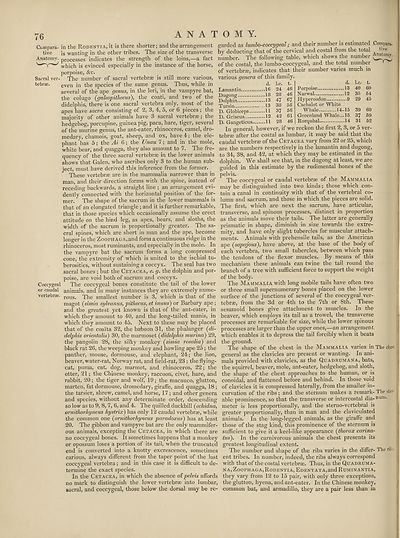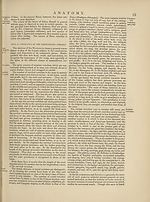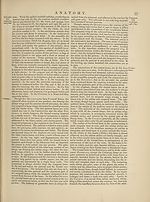Encyclopaedia Britannica > Volume 3, Anatomy-Astronomy
(84) Page 76
Download files
Complete book:
Individual page:
Thumbnail gallery: Grid view | List view

76
ANATOMY.
Compara¬
tive
Anatomy.
in the Rodentia, it is there shorter; and the arrangement
is wanting in the other tribes. The size of the transverse
processes indicates the strength of the loins,—a fact
which is evinced especially in the instance of the horse,
porpoise, &c.
Sacral ver- The number of sacral vertebrae is still more various,
tebrae. even jn the species of the same genus. Thus, while in
several of the ape genus, in the lori, in the vampyre bat,
the colugo (galeopithecus), the coati, and two of the
didelphis, there is one sacral vertebra only, most of the
apes have sacra consisting of 2, 3, 4, 5, or 6 pieces ; the
majority of other animals have 3 sacral vertebrae; the
hedgehog, porcupine, guinea pig, paca, hare, tiger, several
of the murine genus, the ant-eater, rhinoceros, camel, dro¬
medary, chamois, goat, sheep, and ox, have 4; the ele¬
phant has 5; the Ai 6; the Uhau 7; and in the mole,
white bear, and quagga, they also amount to 7. The fre¬
quency of the three sacral vertebrae in the lower animals
shows that Galen, who ascribes only 3 to the human sub¬
ject, must have derived this inference from the former.
These vertebrae are in the mammalia narrower than in
man, and their direction forms with the spine, instead of
receding backwards, a straight line ; an arrangement evi¬
dently connected with the horizontal position of the for¬
mer. The shape of the sacrum in the lower mammals is
that of an elongated triangle ; and it is further remarkable,
that in those species which occasionally assume the erect
attitude on the hind leg, as apes, bears, and sloths, the
width of the sacrum is proportionally greater. The sa¬
cral spines, which are short in man and the ape, become
longer in the Zooph ag a, and form a continuous ridge in the
rhinoceros, most ruminants, and especially in the mole. In
the vampyre bat the sacrum forms a long compressed
cone, the extremity of which is united to the ischial tu¬
berosities, without sustaining a coccyx. The seal has two
sacral bones ; but the Cetacea, e. g. the dolphin and por¬
poise, are void both of sacrum and coccyx.
The coccygeal bones constitute the tail of the lower
animals, and in many instances they are extremely nume¬
rous. The smallest number is 3, which is that of the
magot (simia, sylvanus, pithecus, et inuus) or Barbary ape ;
and the greatest yet known is that of the ant-eater, in
which they amount to 40, and the long-tailed manis, in
which they amount to 45. Next to these may be placed
that of the coai'ta 32, the baboon 31, the phalanger {di¬
delphis orientalis) 30, the marmoset {didelphis marina) 29,
the pangolin 28, the silky monkey {simia rosalia) and
black rat 26, the weeping monkey and howling ape 25 ; the
panther, mouse, dormouse, and elephant, 24; the lion,
beaver, water-rat, Norway rat, and field-rat, 23 ; the flying-
cat, puma, cat, dog, marmot, and rhinoceros, 22; the
otter, 21; the Chinese monkey, raccoon, civet, hare, and
rabbit, 20; the tiger and wolf, 19; the macauco, glutton,
marten, fat dormouse, dromedary, giraffe, and quagga, 18;
the tarsier, shrew, camel, and horse, 17 ; and other genera
and species, without any determinate order, descending
so low as to 9, 8, 7, 6, and 4. The quilled duckbill {echidna,
ornithorhyncus hystrix) has only 12 caudal vertebrae, while
the common one {ornithorhyncus paradoxus) has at least
20. The gibbon and vampyre bat are the only mammifer-
ous animals, excepting the Cetacea, in which there are
no coccygeal bones. It sometimes happens that a monkey
or opossum loses a portion of its tail, when the truncated
end is converted into a knotty excrescence, sometimes
carious, always different from the taper point of the last
coccygeal vertebra; and in this case it is difficult to de¬
termine the exact species.
In the Cetacea, in which the absence of pelvis affords
no mark to distinguish the lower vertebrae into lumbar,
sacral, and coccygeal, those below the dorsal may be re¬
el. Lc
Lamantin 16 24
Dugong 18 28
Dolphin 13 47
Tursio .13 38
D. Globiceps 11 37
D. Griseus 12 42
D. Gangeticus 11 28
Coccygeal
or caudal
vertebrae.
garded as lumbo-coccygeal; and their number is estimated Compara.
by deducting that of the cervical and costal from the total hve
number. The following table, which shows the number
of the costal, the lumbo-coccygeal, and the total number
of vertebrae, indicates that their number varies much in
various genera of this family.
t. d. l.c. t.
46 Porpoise 13 40 60
46 Narwal 12 35 54
67 Hyperoodon 9 29 45
58 Cachalot or White
56 Whale 14-15 39 60
61 Greenland Whale... 15 37 59
46 Rorquhal 14 31 52
In general, however, if we reckon the first 2, 3, or 5 ver¬
tebrae after the costal as lumbar, it may be said that the
caudal vertebrae of the Cetacea vary from 22 or 25, which
are the numbers respectively in the lamantin and dugong,
to 34, 38, and 42, at which they may be estimated in the
dolphin. We shall see that, in the dugong at least, we are
guided in this estimate by the rudimental bones of the
pelvis.
The coccygeal or caudal vertebrae of the Mammalia
may be distinguished into two kinds; those which con¬
tain a canal in continuity with that of the vertebral co¬
lumn and sacrum, and those in which the pieces are solid.
The first, which are next the sacrum, have articular,
transverse, and spinous processes, distinct in proportion
as the animals move their tails. The latter are generally
prismatic in shape, diminish in size towards the extre¬
mity, and have only slight tubercles for muscular attach¬
ments. Animals with prehensile tails, as the American
ape {sapajous), have above, at the base of the body of
each vertebra, two small tubercles, between which pass
the tendons of the flexor muscles. By means of this
mechanism these animals can twine the tail round the
branch of a tree with sufficient force to support the weight
of the body.
The Mammalia with long mobile tails have often two
or three small supernumerary bones placed on the lower
surface of the junctions of several of the coccygeal ver-
tebrae, from the 3d or 4th to the 7th or 8th. These
sesamoid bones give attachment to muscles. In the
beaver, which employs its tail as a trowel, the transverse
processes are remarkable for size, while the lower spinous
processes are larger than the upper ones,—an arrangement
which enables it to depress the tail forcibly when it beats
the ground.
The shape of the chest in the Mammalia varies in The chest
general as the clavicles are present or wanting. In ani¬
mals provided with clavicles, as the Quadrumana, bats,
the squirrel, beaver, mole, ant-eater, hedgehog, and sloth,
the shape of the chest approaches to the human, or is
conoidal, and flattened before and behind. In those void
of clavicles it is compressed laterally, from the smaller in¬
curvation of the ribs ; and the sternum makes a remark- The ster-
able prominence, so that the transverse or intercostal dia-nuni-
meter is less proportionally, and the sterno-vertebral is
greater proportionally, than in man and the claviculated
animals. In the long-legged animals, as the giraffe and
those of the stag kind, this prominence of the sternum is
sufficient to give it a keel-like appearance {thorax carina-
tus). In the carnivorous animals the chest presents its
greatest longitudinal extent.
The number and shape of the ribs varies in the differ- The ril
ent tribes. In number, indeed, the ribs always correspond
with that of the costal vertebrae. Thus, in the Quadruma¬
na, Zoophaga, Rodentia, Edentata,and Ruminantia,
they vary from 12 to 15 pair, with only three exceptions,
the glutton, hyena, and ant-eater. In the Chinese monkey,
common bat, and armadillo, they are a pair less than in
ANATOMY.
Compara¬
tive
Anatomy.
in the Rodentia, it is there shorter; and the arrangement
is wanting in the other tribes. The size of the transverse
processes indicates the strength of the loins,—a fact
which is evinced especially in the instance of the horse,
porpoise, &c.
Sacral ver- The number of sacral vertebrae is still more various,
tebrae. even jn the species of the same genus. Thus, while in
several of the ape genus, in the lori, in the vampyre bat,
the colugo (galeopithecus), the coati, and two of the
didelphis, there is one sacral vertebra only, most of the
apes have sacra consisting of 2, 3, 4, 5, or 6 pieces ; the
majority of other animals have 3 sacral vertebrae; the
hedgehog, porcupine, guinea pig, paca, hare, tiger, several
of the murine genus, the ant-eater, rhinoceros, camel, dro¬
medary, chamois, goat, sheep, and ox, have 4; the ele¬
phant has 5; the Ai 6; the Uhau 7; and in the mole,
white bear, and quagga, they also amount to 7. The fre¬
quency of the three sacral vertebrae in the lower animals
shows that Galen, who ascribes only 3 to the human sub¬
ject, must have derived this inference from the former.
These vertebrae are in the mammalia narrower than in
man, and their direction forms with the spine, instead of
receding backwards, a straight line ; an arrangement evi¬
dently connected with the horizontal position of the for¬
mer. The shape of the sacrum in the lower mammals is
that of an elongated triangle ; and it is further remarkable,
that in those species which occasionally assume the erect
attitude on the hind leg, as apes, bears, and sloths, the
width of the sacrum is proportionally greater. The sa¬
cral spines, which are short in man and the ape, become
longer in the Zooph ag a, and form a continuous ridge in the
rhinoceros, most ruminants, and especially in the mole. In
the vampyre bat the sacrum forms a long compressed
cone, the extremity of which is united to the ischial tu¬
berosities, without sustaining a coccyx. The seal has two
sacral bones ; but the Cetacea, e. g. the dolphin and por¬
poise, are void both of sacrum and coccyx.
The coccygeal bones constitute the tail of the lower
animals, and in many instances they are extremely nume¬
rous. The smallest number is 3, which is that of the
magot (simia, sylvanus, pithecus, et inuus) or Barbary ape ;
and the greatest yet known is that of the ant-eater, in
which they amount to 40, and the long-tailed manis, in
which they amount to 45. Next to these may be placed
that of the coai'ta 32, the baboon 31, the phalanger {di¬
delphis orientalis) 30, the marmoset {didelphis marina) 29,
the pangolin 28, the silky monkey {simia rosalia) and
black rat 26, the weeping monkey and howling ape 25 ; the
panther, mouse, dormouse, and elephant, 24; the lion,
beaver, water-rat, Norway rat, and field-rat, 23 ; the flying-
cat, puma, cat, dog, marmot, and rhinoceros, 22; the
otter, 21; the Chinese monkey, raccoon, civet, hare, and
rabbit, 20; the tiger and wolf, 19; the macauco, glutton,
marten, fat dormouse, dromedary, giraffe, and quagga, 18;
the tarsier, shrew, camel, and horse, 17 ; and other genera
and species, without any determinate order, descending
so low as to 9, 8, 7, 6, and 4. The quilled duckbill {echidna,
ornithorhyncus hystrix) has only 12 caudal vertebrae, while
the common one {ornithorhyncus paradoxus) has at least
20. The gibbon and vampyre bat are the only mammifer-
ous animals, excepting the Cetacea, in which there are
no coccygeal bones. It sometimes happens that a monkey
or opossum loses a portion of its tail, when the truncated
end is converted into a knotty excrescence, sometimes
carious, always different from the taper point of the last
coccygeal vertebra; and in this case it is difficult to de¬
termine the exact species.
In the Cetacea, in which the absence of pelvis affords
no mark to distinguish the lower vertebrae into lumbar,
sacral, and coccygeal, those below the dorsal may be re¬
el. Lc
Lamantin 16 24
Dugong 18 28
Dolphin 13 47
Tursio .13 38
D. Globiceps 11 37
D. Griseus 12 42
D. Gangeticus 11 28
Coccygeal
or caudal
vertebrae.
garded as lumbo-coccygeal; and their number is estimated Compara.
by deducting that of the cervical and costal from the total hve
number. The following table, which shows the number
of the costal, the lumbo-coccygeal, and the total number
of vertebrae, indicates that their number varies much in
various genera of this family.
t. d. l.c. t.
46 Porpoise 13 40 60
46 Narwal 12 35 54
67 Hyperoodon 9 29 45
58 Cachalot or White
56 Whale 14-15 39 60
61 Greenland Whale... 15 37 59
46 Rorquhal 14 31 52
In general, however, if we reckon the first 2, 3, or 5 ver¬
tebrae after the costal as lumbar, it may be said that the
caudal vertebrae of the Cetacea vary from 22 or 25, which
are the numbers respectively in the lamantin and dugong,
to 34, 38, and 42, at which they may be estimated in the
dolphin. We shall see that, in the dugong at least, we are
guided in this estimate by the rudimental bones of the
pelvis.
The coccygeal or caudal vertebrae of the Mammalia
may be distinguished into two kinds; those which con¬
tain a canal in continuity with that of the vertebral co¬
lumn and sacrum, and those in which the pieces are solid.
The first, which are next the sacrum, have articular,
transverse, and spinous processes, distinct in proportion
as the animals move their tails. The latter are generally
prismatic in shape, diminish in size towards the extre¬
mity, and have only slight tubercles for muscular attach¬
ments. Animals with prehensile tails, as the American
ape {sapajous), have above, at the base of the body of
each vertebra, two small tubercles, between which pass
the tendons of the flexor muscles. By means of this
mechanism these animals can twine the tail round the
branch of a tree with sufficient force to support the weight
of the body.
The Mammalia with long mobile tails have often two
or three small supernumerary bones placed on the lower
surface of the junctions of several of the coccygeal ver-
tebrae, from the 3d or 4th to the 7th or 8th. These
sesamoid bones give attachment to muscles. In the
beaver, which employs its tail as a trowel, the transverse
processes are remarkable for size, while the lower spinous
processes are larger than the upper ones,—an arrangement
which enables it to depress the tail forcibly when it beats
the ground.
The shape of the chest in the Mammalia varies in The chest
general as the clavicles are present or wanting. In ani¬
mals provided with clavicles, as the Quadrumana, bats,
the squirrel, beaver, mole, ant-eater, hedgehog, and sloth,
the shape of the chest approaches to the human, or is
conoidal, and flattened before and behind. In those void
of clavicles it is compressed laterally, from the smaller in¬
curvation of the ribs ; and the sternum makes a remark- The ster-
able prominence, so that the transverse or intercostal dia-nuni-
meter is less proportionally, and the sterno-vertebral is
greater proportionally, than in man and the claviculated
animals. In the long-legged animals, as the giraffe and
those of the stag kind, this prominence of the sternum is
sufficient to give it a keel-like appearance {thorax carina-
tus). In the carnivorous animals the chest presents its
greatest longitudinal extent.
The number and shape of the ribs varies in the differ- The ril
ent tribes. In number, indeed, the ribs always correspond
with that of the costal vertebrae. Thus, in the Quadruma¬
na, Zoophaga, Rodentia, Edentata,and Ruminantia,
they vary from 12 to 15 pair, with only three exceptions,
the glutton, hyena, and ant-eater. In the Chinese monkey,
common bat, and armadillo, they are a pair less than in
Set display mode to:
![]() Universal Viewer |
Universal Viewer | ![]() Mirador |
Large image | Transcription
Mirador |
Large image | Transcription
Images and transcriptions on this page, including medium image downloads, may be used under the Creative Commons Attribution 4.0 International Licence unless otherwise stated. ![]()
| Encyclopaedia Britannica > Encyclopaedia Britannica > Volume 3, Anatomy-Astronomy > (84) Page 76 |
|---|
| Permanent URL | https://digital.nls.uk/193758440 |
|---|
| Attribution and copyright: |
|
|---|---|
| Shelfmark | EB.16 |
|---|---|
| Description | Ten editions of 'Encyclopaedia Britannica', issued from 1768-1903, in 231 volumes. Originally issued in 100 weekly parts (3 volumes) between 1768 and 1771 by publishers: Colin Macfarquhar and Andrew Bell (Edinburgh); editor: William Smellie: engraver: Andrew Bell. Expanded editions in the 19th century featured more volumes and contributions from leading experts in their fields. Managed and published in Edinburgh up to the 9th edition (25 volumes, from 1875-1889); the 10th edition (1902-1903) re-issued the 9th edition, with 11 supplementary volumes. |
|---|---|
| Additional NLS resources: |
|

